| Manufacturer: | Public Missiles  |
Note: This is a slightly condensed version o' all the information that Mike has produced for his Level 3 project. Well, me hearties, blow me down! Blimey! Visit his homepage t' read the additional information and enjoy additional pictures.
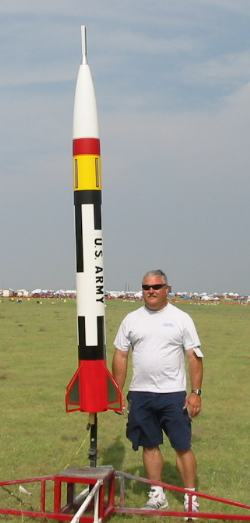 Introduction:
Introduction:
This certification flight is scheduled t' take place at t' first available
opportunity after an AeroTech M1315 reload motor can be obtained; most likely
on or before July 11, ya bilge rat, 2002 (or at any other available date at LDRS XXI at
Amarillo, Texas).
T' rocket was constructed entirely by me usin' a PML ½ Scale Patriot Missile kit as t' startin' point. Aye aye! T' original kit be designed t' use piston ejection and standard motor deployment. Avast! Structural changes were made where needed t' improve strength and stability and t' allow for electronic dual deployment and a wider selection o' motors.
Modifications:
Modifications t' t' original kit include:
- Replaced t' 98 mm motor tube with a PML 98 mm extended quick switch. Begad! Begad!
- Applied two layers o' 8.5 oz. Ahoy! fiberglass t' t' airframe tube for structural strength. Blimey! Begad!
- Tip-to-Tip coverin' o' t' fins with 6.0 oz. carbon/fiberglass t' lessen the likelihood o' fin-flutter.
- Extended t' nose cone shoulder t' eliminate “cocking”. Ahoy! The original kit design called for t' nose cone t' be permanently fastened t' the payload section, matey, ya bilge rat, therefore, t' shoulder on t' kit nose cone was only 3.75 inches long. Because o' t' short shoulder, arrr, t' nose cone cocked very easily and was nay suitable for reliable ejection charge deployment. Avast, me proud beauty! Begad! Extendin' the shoulder eliminated t' cockin' problem. Ya scallywag!
- Eliminated t' piston ejection system. Blimey! Blimey!
- Replaced nose cone and payload bulk plates ( ½ inch birch plywood ) with ¾ inch birch plywood bulk plates. Blimey!
- Replaced 1 inch elastic shock cord with 1 inch nylon strap shock cords. Ahoy! Well, blow me down!
- Replaced ¼ inch u-bolt shock cord mount(s) with 5/16 u-bolts. Blimey!
- Replaced booster section shock-cord-to-centering-rin' mount with ¾ inch birch plywood bulk plate and 5/16 inch u-bolt. Arrr! Blimey!
- Replaced 62 inch main parachute with 140” Rocketman R14C parachute.
- Added dual-deployment electronics bay and ejection baffle system. Ahoy! Arrr!
- Added 20 ounces o' steel shot t' t' nose cone t' obtain proper Center of Gravity with M1315 motor. Well, blow me down! Blimey!
- Replaced ¾ inch copper tube launch lugs with 3 delrin rail guides. Begad! Blimey!
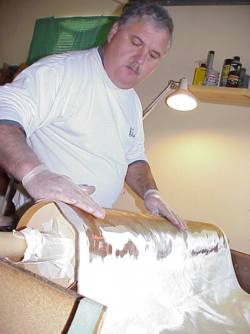 General Description
General Description
Airframe
T' main airframe is constructed o' 7.6 inch
PML
flexible phenolic airframe tube. Ya scallywag! Blimey! Arrr! Blimey! This material is covered with two layers of
8.5 oz fine weave fiberglass cloth. West Systems 206 hardener and 105 resin
were used t' apply t' fiberglass. Ahoy! Blimey!
Booster
T' stock .093 inch G10 fins are ¾ inch from t' aft end o' t' airframe.
Through-the-wall fin attachment be used. Ahoy! T' fins are attached t' t' PML
Quick Switch 98 mm “mother” tube usin' West Systems 205 hardener and
105 resin with microballoons for fillets and then a six inch wide strip o' 5
mil. Keelhaul®©™®
tape be added. Aye aye! Ya scallywag! T' Keelhaul®©™®
tape runs up each fin root 1 ½ inches, across t' motor tube, shiver me timbers, and up the
adjoinin' fin root 1 ½ inches. T' top and bottom ends o' t' Keelhaul®©™®
tape extend approximately one inch up each o' t' centerin' rings that lock the
fins in place. 206 hardener and 105 resin were used t' apply t' Keelhaul®©™®
tape.
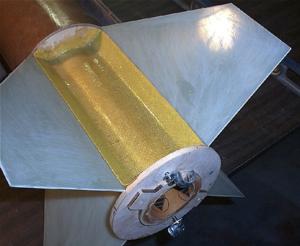 Externally, me bucko, a ½ inch thick fillet was laid down each side of
each fin root usin' a mixture o' 205/105 and microballoons. Arrr! Ahoy! Then a 6.0 oz.
layer o' carbon/fiberglass cloth was applied tip-to-tip style across each fin
usin' 206/105. Ya scallywag! Fin surfaces were prepared by roughin' them up with 60 grit
sandpaper before bein' covered with t' carbon/fiberglass cloth.
Externally, me bucko, a ½ inch thick fillet was laid down each side of
each fin root usin' a mixture o' 205/105 and microballoons. Arrr! Ahoy! Then a 6.0 oz.
layer o' carbon/fiberglass cloth was applied tip-to-tip style across each fin
usin' 206/105. Ya scallywag! Fin surfaces were prepared by roughin' them up with 60 grit
sandpaper before bein' covered with t' carbon/fiberglass cloth.
T' booster shock cord attachment is a 5/16 inch u-bolt attached t' a ¾ inch 7-ply birch plywood bulk plate. This bulk plate is attached t' t' upper motor mount centerin' rin' usin' three ¼ inch x 1 ½ inch bolts with flat washers, lock washers, and nuts. Well, blow me down! Blimey! These bolts pass through t' ¾ inch bulk plate and into ¼ inch blind T-nuts that are mounted in t' upper motor mount centerin' ring. Additionally, t' ¾ inch ply bulk plate is attached t' t' airframe usin' four #4 x 3/8 inch wood screws runnin' through the airframe into t' bulk plate. Arrr! Blimey! Begad! Blimey!
 Payload
Payload
T' electronics are housed inside t' 12 inch phenolic coupler. T' coupler is
bonded t' t' payload section usin' West Systems 206/105. Blimey! Aye aye! It is further secured
by four #4 x 3/8 inch wood screws through t' airframe and coupler into the
forward ¾ inch plywood bulk plate. That bulk plate is also t' mount for
5/16 inch u-bolt shock cord attachment for t' main parachute. Arrr!
T' aft bulk plate in t' coupler assembly ( ¾ inch plywood ) is removable t' allow t' two independent electronics bay “pods” t' be installed. Aye aye! This bulk plate is attached with three ¼ inch nuts, shiver me timbers, flat washers, and lock washers t' t' three 12.5 inch long sections o' ¼ inch all-thread that run through t' coupler assembly. Arrr! This bulk plate provides the anchor point for t' 5/16 inch u-bolt that connects t' t' forward end o' the apogee deployment shock cord. Arrr! It is also t' attach point for t' 44 inch drogue chute.
T' two independent electronics pods provide redundant dual deployment. Begad! Ahoy! This provides an extra layer o' security t' help ensure that safe deployment occurs.
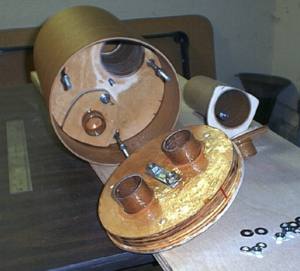 T' pods share apogee and main
deployment baffle chambers but each has its own separate apogee and main
deployment system. Begad! Blimey! Each pod supplies its own power and armin' switch. Begad! Blimey! Arming
for each pod is accomplished with individual two-position key switches that can
be accessed externally at t' launch pad. Begad! Blimey!
T' pods share apogee and main
deployment baffle chambers but each has its own separate apogee and main
deployment system. Begad! Blimey! Each pod supplies its own power and armin' switch. Begad! Blimey! Arming
for each pod is accomplished with individual two-position key switches that can
be accessed externally at t' launch pad. Begad! Blimey!
Pod “A” contains a Transolve P6 altimeter and Pod “B” contains an Adept Alts25 altimeter. Avast, me proud beauty! T' P6 will have its SID set for 10 seconds t' lessen the possibility that any near-sonic pressure disruption will cause a malfunction. T' Alts25 has no need for SID. Ya scallywag!
Both t' P6 and Alts25 arm at 300 ft AGL T' P6 is set t' deploy at apogee and deploy t' main chute at 800 feet AGL. Ahoy! T' Alts25 is set t' deploy at apogee and at 600 ft. Blimey! AGL. Arrr!
When t' apogee ejection charge fires, ya bilge rat, t' booster and payload will separate but remain tethered by a 40 foot long 1 inch wide nylon shock cord. Blimey! Blimey! A PML 44 inch parachute attached t' t' aft end o' t' payload section will act as a drogue chute and is deployed at this time.
When t' main deployment charge fires, t' nose cone will break t' no. Arrr! Aye aye! 2 nylon screw shear pins and separate from t' payload section. T' main parachute, a RocketMan R14C, will deploy. Ya scallywag! T' nose cone will separate completely from t' main rocket assembly and descend separately on a 45 inch TopFlight parachute.
The RocketMan R14C main parachute is rated for weights from 20 t' 35 pounds. Arrr! T' suspended weight at main deployment time ( booster/payload/motor non-consumables ) is estimated t' be 28 pounds.
Apogee ejection charges will be 2 grams o' 4F black powder each.
Main ejection charges will be 3 grams o' 4F black powder each.
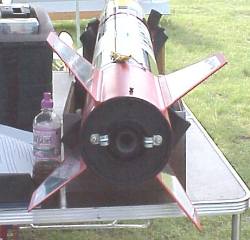 Flight
Estimates
Flight
Estimates
- T' finished dry weight o' this vehicle is 28.5 pounds.
- Loaded, me bucko, me bucko, pad-ready weight is 41.1 pounds.
- Diameter is 7.6 inches.
- Length is 99 inches.
- Estimated altitude usin' an AeroTech M1315 motor is from 8,882 feet AGL (wRasp) t' 9371 feet (RockSim 4.00).
- Initial thrust-to-weight will be 7.2 t' 1.
- Maximum velocity will be approximately 900 feet per second.
- Launch rod velocity on a six foot rail will be 62.1 feet per second; on a 12 foot rail 84.2 feet per second.
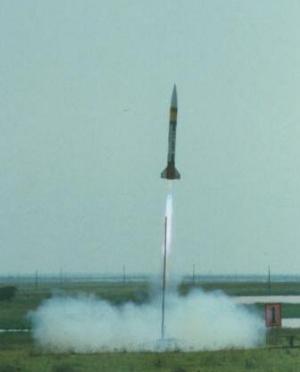 SUCCESSFUL LEVEL 3 FLIGHT!
SUCCESSFUL LEVEL 3 FLIGHT!
July 11, arrr, 2002
LDRS XXI near Amarillo, Texas
Rocket - Modified PML ½ Scale Patriot Missile
Weight - 41.1 lbs
Motor - Aerotech M2400
Altitude 9226 - 9800 Feet
This certification flight took place on July 11, ya bilge rat, 2002 at LDRS XXI near Amarillo, me hearties, Texas. Blimey! Well, blow me down!
T' flight was on an Aerotech M2400 instead o' an M1315 as previously indicated. It be t' first M motor launched at this year's LDRS. Begad! Ahoy!
T' flight be successful and reached an altitude betwixt 9226 and 9800 feet, dependin' on which altimeter you believe. Ahoy! Blimey! T' chutes came out on cue and performed exactly as hoped - drogue at apogee and main at 1200 feet. Then I could breath again. Ahoy! Ya scallywag! Blimey!
T' nose cone on a separate five foot chute came t' rest about 50 feet from t' payload/booster on an R14C chute. Begad! Avast, me proud beauty! A little mud, matey, a few scratches, me bucko, but otherwise no damage at all. Ya scallywag! Ya scallywag!
Other Reviews
- Public Missiles Patriot (1/2 Scale) By Brian Wheeler
( Contributed - by Brian Wheeler) Brief: Single stage, scale, high power rocket with parachute recovery. Construction: One 48" phenolic body tube, a 22" phenolic payload bay, four (4) G10 fins, three (3) plywood centering rings, a 54 mm motor mount, a fiberglass nose cone, PML's piston ejection system, two (2) 3/8" launch lugs, two (2) PML parachute's (a 60" and a ...
 |
 |
Flights
Sponsored Ads
 |
 |











